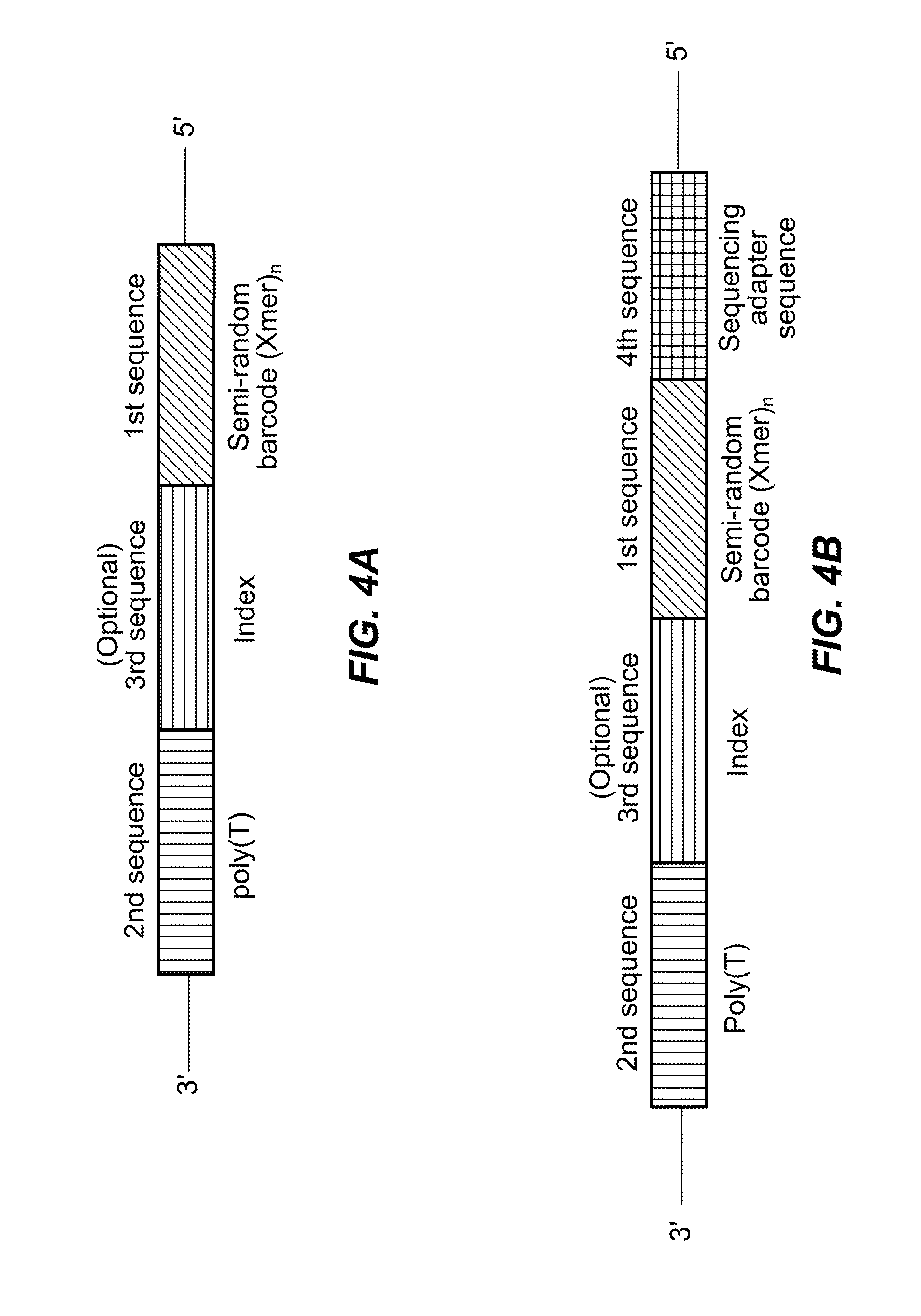Semi-random barcodes for nucleic acid analysis
a nucleic acid analysis and semi-random technology, applied in the field of nucleic acid sequencing, can solve the problems of introducing a large number of errors, affecting the quality of nucleic acid analysis, and requiring a large number of barcodes. large, the difficulty of generating a large number of such barcodes is high, and the effect of reducing the number of errors
- Summary
- Abstract
- Description
- Claims
- Application Information
AI Technical Summary
Benefits of technology
Problems solved by technology
Method used
Image
Examples
example 1
Construct Semi-Random Barcode Adapter for Illumina Sequencing Platform
[0262]The trimer mix that contains 8 trimers (AAC, ACT, ATG, CAG, CGT, GAA, GTT, TGC) was purchased from Glen Research Corporation (Sterling, Va.). All oligonucleotides were synthesized by Integrated DNA Technologies (Coralville, Iowa).
Barcoded Illumina Strand (Semi-Random):(SEQ ID NO: 21)5′-Phos / GATC / iTriMix / / iTriMix / / iTriMix / / iTriMix / AGATCGGAAGAGCACACGTC*T-3′
[0263]“Phos” refers to a 5′ phosphate group. “iTriMix” refers to one of the 8 trimers.
Illumina Fill-In Primer:(SEQ ID NO: 22)5′-AATGATACGGCGACCACCGAGATCTACACTCTTTCCCTACACGACGCTCTTCCGAT*C*T-3′
[0264]* denotes a phosphorothioate bond
[0265]The following is the protocol for construction of semi-random barcode adapter for Illumina sequencing:
Strand Annealing and Primer Extension
[0266]1) Dilute Klenow Large Fragment Enzyme (NEB MO210S) to working concentration of 0.4 U / uL using 1×NEB Buffer 2[0267]2) Set up the following strand annealing / primer extension reaction o...
example 2
Evaluating the Diversity of Synthesized Semi-Random Barcodes Through NGS
[0275]An ACTB amplicon was used as the template in library construction using semi-random barcode adapters. The ACTB amplicon was generated by PCR using a pair of ACTB specific primers and human cDNA. The purified amplicon was then used as the template in constructing NGS libraries following QIAGEN GeneRead DNA library Prep kit for Illumina, except that semi-random adapter was used instead of regular adapters.
[0276]First, the end-repair was done using 200 ng purified ACTB amplicon, 10× end-repair buffer and 2 ul end-repair enzyme mix in a 25 ul reaction. After incubation at 25° C. for 30 minutes and at 75° C. for 25 minutes, 3 ul A-addition buffer together with 3 ul Klenow fragment (3′-5′ exo-) were added to the tube. The reaction was further incubated at 37° C. for 30 minutes, then at 75° C. for 10 minutes. Then 45 ul 2× ligation buffer, 2.5 ul of 48 uM semi-random barcode adapters, 4 ul T4 DNA ligase and water...
example 3
Using Semi-Random Barcode Adapter in RNA Quantification
[0284]The ERCC RNA control was used as reference materials. It contained a mixture of 92 in vitro transcribed RNA molecules at defined concentrations spanning 6 logs. Each RNA transcript had a polyA tail and ranged from 200 nucleotides to 2500 nucleotides long.
[0285]The ERCC RNA control was developed by the National Institute of Standards and Technology (NIST) and purchased from Life Technologies.
[0286]To evaluate the accuracy of RNA-seq quantification using molecular barcodes, a cDNA library of 30 ng ERCC RNA controls was constructed using semi-random Illumina adapters and NEB low input mRNA-seq protocol. The library was prepared using NEBNext Ultra Directional RNA Library Prep Kit for Illumina. 30 ng ERCC RNA Spike-In Control Mix 1 was used. The kit instructions were followed to construct the RNASeq library except semi-random barcode adapters were used instead of NEB adapters in the ligation step. After library quantification ...
PUM
| Property | Measurement | Unit |
|---|---|---|
| length | aaaaa | aaaaa |
| temperature | aaaaa | aaaaa |
| temperature | aaaaa | aaaaa |
Abstract
Description
Claims
Application Information
 Login to View More
Login to View More - R&D
- Intellectual Property
- Life Sciences
- Materials
- Tech Scout
- Unparalleled Data Quality
- Higher Quality Content
- 60% Fewer Hallucinations
Browse by: Latest US Patents, China's latest patents, Technical Efficacy Thesaurus, Application Domain, Technology Topic, Popular Technical Reports.
© 2025 PatSnap. All rights reserved.Legal|Privacy policy|Modern Slavery Act Transparency Statement|Sitemap|About US| Contact US: help@patsnap.com



